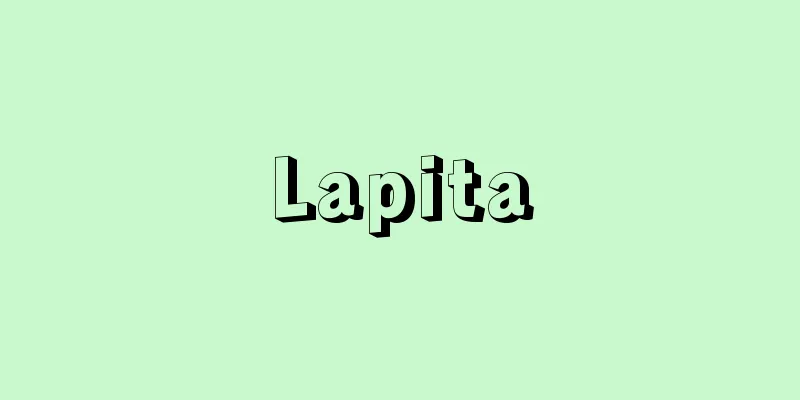E. coli - Daichokin

|
In the narrow sense, it refers to bacteria belonging to the genus Escherichia in the family Enterobacteriaceae, and in the broad sense, it refers to the coliform group including Citrobacter , Klebsiella , and Enterobacter . In the narrow sense, E. coli is a gram-negative rod-shaped bacterium measuring 0.5 to 1.5 micrometers wide and 2 to 6 micrometers long (1 micrometer is one millionth of a meter), which is peritrichous, although some strains lack flagella. It is facultatively anaerobic. It grows well on normal culture media, forming smooth, opaque, white colonies. E. coli breaks down glucose, lactose, and mannitol (and sometimes sucrose and salicin), producing acid and gas. However, it does not produce hydrogen sulfide, and does not break down urea. E. coli is a normal bacterium that lives in the intestinal tract of humans and animals, and is found at 108 cells per gram of intestinal contents. It is a beneficial bacterium that aids digestion, produces vitamins, aids the flow of intestinal contents, and eliminates harmful bacteria that invade the intestinal tract. However, some E. coli can acquire pathogenicity for some reason and become the cause of infectious diseases that cause symptoms such as diarrhea and gastroenteritis. It is classified into five types based on its pathogenicity. The pathogenic E. coli O157, which has become a problem in recent years, is the enterohemorrhagic type. (1) Enteropathogenic E. coli: This causes acute gastroenteritis similar to Salmonella enteritis. It mainly affects children, causing fever, vomiting, and watery diarrhea. Serotypes of E. coli include O26, O44, O55, O86, O111, O114, O119, O125, O127, O128, O142, and O158. (2) Enteroinvasive E. coli Invades the mucous membrane of the large intestine, destroying cells and causing symptoms similar to dysentery. It causes fever, abdominal pain, and watery diarrhea. Serotypes of E. coli are O28, O112, O121, O124, O136, O143, O144, O152, and O164. (3) Enterotoxigenic E. coli: Causes cholera-like diarrhea. Known as infant diarrhea and traveler's diarrhea in developing countries. Serotypes of E. coli are O6, O8, O11, O15, O25, O27, O29, O63, O73, O78, O85, O114, O115, O128, O139, O148, O149, O159, O166, and O169. (4) Enterohemorrhagic E. coli: Infection occurs through insufficiently cooked meat, milk (high carrier rate in cows), and uncooked vegetables. It can also be transmitted from person to person, so it is not simply food poisoning. The causative agent is verotoxin (shiga-toxin) produced by the bacteria, which inhibits protein synthesis and causes cell death. Serotypes of E. coli include O26, O103, O111, O128, O145, and O157. After a relatively long incubation period (3 to 7 days), infection with O157 causes symptoms such as abdominal pain, diarrhea, and fever, and often followed by bloody stools. (5) Enteroaggregative E. coli: A group of bacteria that form aggregates and adhere to intestinal epithelial cells. They produce heat-resistant enterotoxins. They are believed to be the cause of chronic diarrhea in children, and symptoms include watery diarrhea, vomiting, dehydration, and sometimes fever and bloody stools. Serotypes of E. coli are O44, O127, and O128. Coliform bacteria are often used as an indicator of fecal contamination in hygiene inspections of drinking water, food, and even beaches and public baths. This is because fecal contamination can indicate the presence or suspicion of digestive infectious bacteria such as Shigella and Salmonella typhoid, as well as food poisoning bacteria such as Salmonella and pathogenic E. coli. However, coliform bacteria themselves are not harmful bacteria and do not grow in nature except in the intestinal tract, which is why they are used as an indicator of contamination. [Masami Soneda] "Easy-to-understand Symptoms, Diagnosis, and Treatment of Enterohemorrhagic E. coli (O157, etc.) Infections" revised edition (1997, Ministry of Health, Labor and Welfare, Health and Medical Bureau, Tuberculosis and Infectious Diseases Division) Source: Shogakukan Encyclopedia Nipponica About Encyclopedia Nipponica Information | Legend |
|
狭義には、腸内細菌科エッシェリキア属に属する細菌をいい、広義には、シトロバクターCitrobacter、クレブシエラKlebsiella、エンテロバクターEnterobacterなどを含めた大腸菌群をさす。狭義の大腸菌は、幅0.5~1.5マイクロメートル、長さ2~6マイクロメートル(1マイクロメートルは100万分の1メートル)のグラム陰性の桿菌(かんきん)で周毛性であるが、菌株によっては鞭毛(べんもう)のないものもある。通性嫌気性。通常の培養基によく発育し、平滑型、不透明で白色の集落(コロニー)をつくる。大腸菌はブドウ糖、乳糖、マンニットを分解し(ときにはショ糖やサリシンも分解する)、酸とガスを産生する。しかし、硫化水素は産生せず、尿素の分解も行わない。 大腸菌はヒトならびに動物の腸管内に生息する常在菌であり、腸管内容物1グラム当り108個含まれている。消化を助け、ビタミンを生産し、腸内容物の流動を助け、腸管内へ侵入する有害菌を排除する働きをもつ有益な細菌である。しかし、大腸菌のなかには、なんらかの理由で病原力を獲得して、下痢や胃腸炎などの症状をおこす感染症の原因となるものがある。病原性によって5型に分類される。近年問題となっている病原大腸菌O157は腸管出血型である。 (1)腸管病原性大腸菌 サルモネラ腸炎に似た急性胃腸炎として発症する。おもに小児に発熱、嘔吐(おうと)、水様性下痢をおこす。O26、O44、O55、O86、O111、O114、O119、O125、O127、O128、O142、O158の血清型大腸菌。 (2)腸管侵入性大腸菌 大腸の粘膜に侵入し、細胞を破壊し、赤痢に似た症状となる。発熱、腹痛、水様性下痢をおこす。O28、O112、O121、O124、O136、O143、O144、O152、O164の血清型大腸菌。 (3)毒素原性大腸菌 コレラ様の下痢をおこす。開発途上国での乳幼児下痢症、旅行者下痢症として知られている。O6、O8、O11、O15、O25、O27、O29、O63、O73、O78、O85、O114、O115、O128、O139、O148、O149、O159、O166、O169の血清型大腸菌。 (4)腸管出血性大腸菌 加熱不十分な肉類や牛乳(ウシの保菌率が高い)や非加熱の野菜などから感染。ヒトからヒトへも感染し、単なる食中毒ではない。病原因子は菌の生産するベロ毒素(シガトキシンShiga-toxin)でタンパク質合成阻害作用をもち、細胞致死作用を示す。O26、O103、O111、O128、O145、O157の血清型大腸菌。 O157による感染症は比較的長い潜伏期(3~7日)の後、腹痛、下痢、発熱の症状があり、次に血便となることが多い。 (5)腸管凝集付着性大腸菌 細菌が凝集塊となって、腸上皮細胞に付着する性質をもつ菌群。耐熱性の腸管毒を産生する。小児の慢性下痢症の原因とされ、水様性下痢、嘔吐、脱水症状、ときには発熱、血便がみられる。O44、O127、O128の血清型大腸菌。 大腸菌群は糞便(ふんべん)汚染の指標として、飲料水や食品、さらには海水浴場や公衆浴場などの衛生検査によく使われる。これは糞便汚染があれば、消化器系伝染病菌である赤痢菌や腸チフス菌のほか、食中毒菌であるサルモネラ菌や病原大腸菌の存在、もしくはその疑いがもたれるからである。しかし、本来、大腸菌群自体は有害菌ではなく、腸管内以外の自然界では増殖しないことから汚染指標として使われているわけである。 [曽根田正己] 『厚生省保健医療局結核感染症課監修『よくわかる腸管出血性大腸菌(O157等)感染症の症状・診断・治療』改訂版(1997・厚健出版)』 出典 小学館 日本大百科全書(ニッポニカ)日本大百科全書(ニッポニカ)について 情報 | 凡例 |
<<: Coliform group count - daichoukingunsuu (English spelling) count of coliform group
Recommend
isokeraunic level
…Any day on which lightning discharges (lightning...
Suma-to Genpei Azalea - Suma-to Genpei Azalea
Bunraku puppet theater. Historical piece. Five act...
Kamalaśīla (English spelling)
A Buddhist scholar of the Indian Yogacara Madhya ...
Sanskrit (English spelling)
A language belonging to the Indo-European branch o...
Elasmobranchii
…A general term for fishes belonging to the Elasm...
Scoliosis - scoliosis
Also called scoliosis. A condition in which the sp...
Patan (English spelling)
A city in the northern part of Gujarat, western In...
Ring spinning - Wamawashi
A game in which a bamboo or iron hoop is placed o...
Moyamoya disease
What kind of disease is it? ●Main symptoms and pro...
Chaeroneia - English spelling: Chaironeia
An ancient city in the northwestern tip of Boeoti...
Ticket system - Ticket system
〘noun〙① A system in which you buy tickets to watch...
Britannia Royal Naval College
...The site of the facility is currently used by ...
Henri de Guise - Henri de Guise
…France had been in the midst of the Religious Wa...
Chonos (Islands) (English spelling) Archipelago of the Chonos
An archipelago on the Pacific coast south of Chilo...
Reduce rent and reduce stress - Genso Gensoku (English spelling) Jian-zu Jian-xi
The Chinese Communist Party's policy of loweri...









